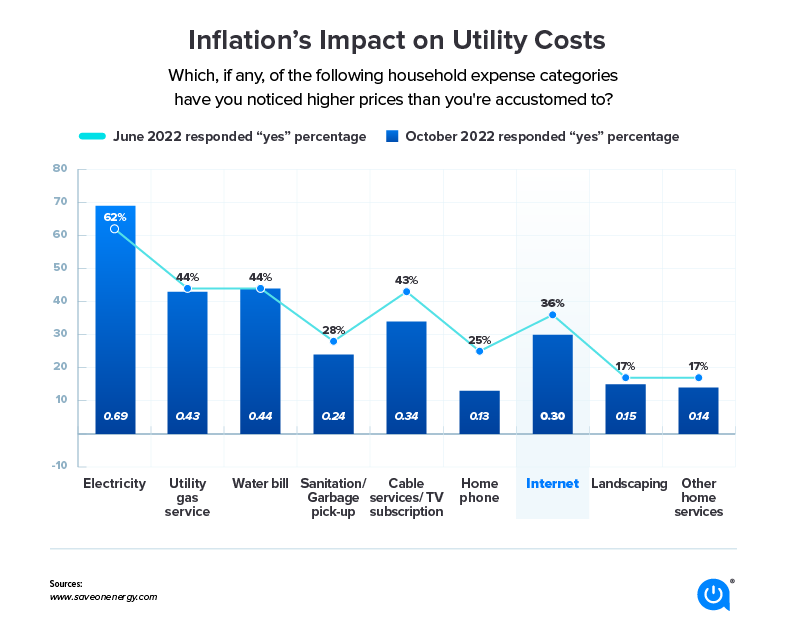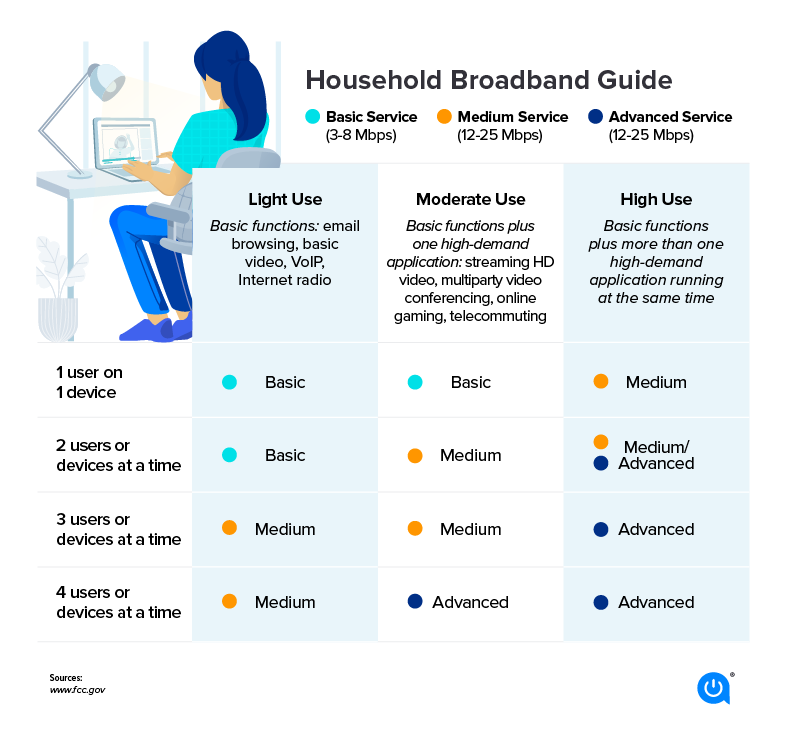Amid a record-setting rise in inflation rates, Americans are noticing increases in the prices of their utilities, including their monthly internet bills.
Key Findings
- 30% of survey respondents noticed higher internet prices between June and August of 2022.
- Most internet subscriptions now exist within the 200 to 400 Mbps speed tiers, much higher than the minimum standard broadband speed identified by FCC (25/3 Mbps).
- Gigabit speed tier subscribers increased by 35% and now account for over 15% of all subscribers.
- More people are choosing to subscribe to higher speeds, either out of personal necessity or because their ISP is increasing its speed tiers.
Current state of utility price increases and inflation rates
In its February report, the U.S. Bureau of Labor Statistics reported a rise in the consumer price index (CPI) by 12.9% for electricity and 14.3% for natural gas over the last 12 months. These record-high prices mirror the high inflation rates over the past few years — 7% in 2021 and 6.5% in 2022.
Consumers have noticed their internet bills increasing, although at a slower rate than other utilities. According to a survey by YouGov for SaveOnEnergy.com, 36% of respondents saw higher internet prices than in 2021. 30% of respondents noticed higher prices between June and August of 2022. It’s safe to say that utility prices have been increasing in all sectors, including broadband.
With rising costs, consumers start seeking ways to trim their increased monthly budget. Reminiscent of parents telling kids to turn off lights when they leave a room to save on the electric bill, you can also find ways to lower your internet bill.

Current state of household internet speeds and availability
ISPs have continuously increased their speed tiers and expanded their networks, resulting in more consumers subscribing to plans with higher speeds.
In the FCC’s twelfth Measuring Broadband America (MBA) report, the weighted average download speed of participating ISPs was 307.73 Mbps — 59% higher than the eleventh report and 111% higher than the tenth.
OpenVault’s Broadband Insights Q3 2022 report found that most internet subscriptions now exist within the 200 to 400 Mbps speed tiers. It also reports that gigabit speed tier subscribers increased by 35% and now account for over 15% of all subscribers.
This data shows that more people are choosing to subscribe to higher speeds, either out of personal necessity or because their ISP is increasing its speed tiers.
Do you really need that much speed?
With the challenges facing the economy, it’s important to analyze if the internet you pay for is really the speed you need.
The FCC identifies 25/3 Mbps as the minimum standard broadband speed. This is far less speed than the above data points from recent broadband reports — so how much speed do you really need? Are you paying for too much bandwidth?
According to the Information Technology and Innovation Foundation (ITIF), basic web browsing requires 1 Mbps of speed, Zoom requires 3 Mbps download/3.8 Mbps upload and streaming in 4K requires at least 15 Mbps of internet speed.

The FCC’s Household Broadband Guide claims that the average student or person working from home only requires a connection between 5 and 25 Mbps — much lower than the 200 to 400 Mbps speed range that most people subscribe to.
While the speed you need will vary based on the number of devices, users and type of internet activity, you could be paying for more speed than you need if you fall within the FCC guide’s criteria.
How to reduce your internet bill
If you feel like you’re paying too much for internet, there are steps you can take to reduce your bill:
- Find out what speed you need: First, you need to find out what speed you need for your daily internet activities before subscribing to a plan. This could save you money by preventing you from subscribing to a more expensive plan.
- Compare available plans in your area: Compare all available plans in your area to ensure you’re getting the best deal. Some ISPs may offer a lower price for plans similar to other providers.
- Buy your own equipment: Many ISPs offer rental equipment that you’ll have to pay a monthly fee for. Buying your equipment is cheaper in the long run.
- Bundle your services: Many ISPs offer bundle packages with internet, TV and phone that can save you money. If you have different providers for each service, it may be smart to look into bundling them under one provider.
- Negotiate your bill: If you’re considering switching providers to save money, you could try negotiating your bill with your current provider first. ISPs don’t want to lose customers, so trying to negotiate a lower bill is worth a shot.
Methodology and sources
The data shared in this article is drawn from the following sources:
- Information Technology and Innovation Foundation
- The FCC’s Household Broadband Guide
- The FCC’s twelfth Measuring Broadband America fixed broadband report
- The U.S. Bureau of Labor Statistics Consumer Price Index 2022 summary
- The U.S. Inflation Calculator
- OpenVault’s Broadband Insights Q3 2022 report
The bottom line
More and more people are subscribing to higher internet speed tiers, but it’s important to consider if you really need the speed you’re paying for. With heightened utility prices and inflation rates, saving on your internet bill could make a big difference. Find out what speed you need for your internet activities and explore other ways to reduce your internet bill.
Allconnect: Let us compare providers for you
Why should you choose Allconnect? We’re the #1 broadband marketplace in the U.S, meaning you can trust us to search, compare and order internet and TV service for your home.
Get started

Written by:
Camryn Smith
Cammy is a writer with Allconnect, growing her broadband industry knowledge for over a year on the internet marketplace. Her expertise lies in home internet and broadband service with a focus on providers, plans…
Read more
Edited by:
Robin LaytonEditor, Broadband Content
-
Featured
![Report: Internet users are gobbling data by more than a half-terabyte]() Report: Internet users are gobbling data by more than a half-terabyte Robin Layton — 4 min read
Report: Internet users are gobbling data by more than a half-terabyte Robin Layton — 4 min read -
Featured
![How to lower your internet bill]() How to lower your internet bill Camryn Smith — 6 min read
How to lower your internet bill Camryn Smith — 6 min read -
Featured
![How much internet speed do I need?]() How much internet speed do I need? Joe Supan — 10 min read
How much internet speed do I need? Joe Supan — 10 min read
Latest
-
Thursday, April 18, 2024
Comcast introduces new pre-paid internet, mobile and streaming plansRobin Layton — 2 min read
-
Thursday, April 18, 2024
T-Mobile imposes data cap of 1.2TB/mo.Robin Layton — 2 min read
-
Thursday, April 18, 2024
What is a portable Wi-Fi hotspot?Robin Layton — 6 min read






